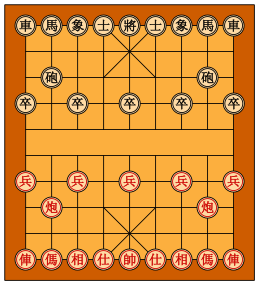Xianqi

Xiangqi board and starting setup
|
|
| Genre(s) |
Board game Abstract strategy game |
|---|---|
| Players | 2 |
| Setup time | < 1 minute |
| Playing time | Informal games: may vary from 20 minutes to several hours Blitz games: up to 10 minutes |
| Random chance | None |
| Skill(s) required | Strategy, tactics |
| Synonym(s) | Chinese chess Elephant game Elephant chess |
| Xiangqi | |||||||||||||||||||||
| Chinese | 象棋 | ||||||||||||||||||||
|---|---|---|---|---|---|---|---|---|---|---|---|---|---|---|---|---|---|---|---|---|---|
|
|||||||||||||||||||||
| Transcriptions | |
|---|---|
| Standard Mandarin | |
| Hanyu Pinyin | xiàngqí |
| Wade–Giles | hsiang4-ch'i2 |
| Yale Romanization | syàng chí [ |
| Yue: Cantonese | |
| Yale Romanization | jeuhng kéi |
| Jyutping | zoeng6 kei2 |
| Southern Min | |
| Hokkien POJ | chhiūⁿ-kî |
Xiangqi (Chinese: 象棋; pinyin: xiàngqí), also called Chinese chess, is a strategy board game for two players. It is one of the most popular board games in China, and is in the same family as Western (or international) chess, chaturanga, shogi, Indian chess and janggi. Besides China and areas with significant ethnic Chinese communities, xiangqi (cờ tướng) is also a popular pastime in Vietnam.
The game represents a battle between two armies, with the object of capturing the enemy's general (king). Distinctive features of xiangqi include the cannon (pao), which must jump to capture; a rule prohibiting the generals from facing each other directly; areas on the board called the river and palace, which restrict the movement of some pieces (but enhance that of others); and placement of the pieces on the intersections of the board lines, rather than within the squares.
Xiangqi is played on a board nine lines wide and ten lines long. As in the game Go (Wéiqí 圍棋/围棋), the pieces are placed on the intersections, which are known as points. The vertical lines are known as files (columns), and the horizontal lines are known as ranks (rows).
Centered at the first to third and eighth to tenth ranks of the board are two zones, each three points by three points, demarcated by two diagonal lines connecting opposite corners and intersecting at the center point. Each of these areas is known as 宮/宫 ![]() gōng, a castle.
gōng, a castle.
...
Wikipedia
